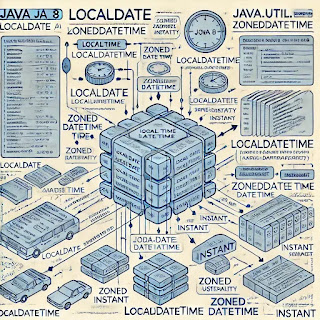Java Date and Time API (Java 8)
Introduction
Java 8 introduced a brand-new Date and Time API in the java.time package, addressing the long-standing issues with java.util.Date and java.util.Calendar. The new API provides a more flexible, powerful, and easy-to-use approach to handling date and time in Java applications.
In this article, we will explore the various classes and functionalities provided by the Java 8 Date and Time API with examples.
Problems with Old Date and Time API
Before Java 8, date and time handling relied on the java.util.Date, java.util.Calendar, and java.text.SimpleDateFormat classes, which had several issues:
-
Mutability:
DateandCalendarobjects were mutable, making them unsafe for multi-threaded environments. -
Poor API design: Many methods had misleading names, such as
getYear(), which returnedyear - 1900. -
Lack of thread safety:
SimpleDateFormatwas not thread-safe, causing issues in concurrent applications. -
Limited functionality: The old API lacked support for operations such as time zones, date arithmetic, and formatting.
To overcome these issues, Java 8 introduced the java.time package.
Key Classes in Java 8 Date and Time API
The new Date and Time API provides several classes to handle different date and time operations:
1. LocalDate - Date without Time
LocalDate represents a date without time or time zone information.
import java.time.LocalDate;
public class LocalDateExample {
public static void main(String[] args) {
LocalDate today = LocalDate.now();
System.out.println("Current Date: " + today);
LocalDate specificDate = LocalDate.of(2025, 3, 23);
System.out.println("Specific Date: " + specificDate);
}
}
2. LocalTime - Time without Date
LocalTime represents time without date or time zone information.
import java.time.LocalTime;
public class LocalTimeExample {
public static void main(String[] args) {
LocalTime now = LocalTime.now();
System.out.println("Current Time: " + now);
}
}
3. LocalDateTime - Date and Time Without Time Zone
LocalDateTime is a combination of LocalDate and LocalTime.
import java.time.LocalDateTime;
public class LocalDateTimeExample {
public static void main(String[] args) {
LocalDateTime dateTime = LocalDateTime.now();
System.out.println("Current Date and Time: " + dateTime);
}
}
4. ZonedDateTime - Date and Time with Time Zone
ZonedDateTime represents a date and time with a time zone.
import java.time.ZonedDateTime;
import java.time.ZoneId;
public class ZonedDateTimeExample {
public static void main(String[] args) {
ZonedDateTime zonedDateTime = ZonedDateTime.now(ZoneId.of("America/New_York"));
System.out.println("Date and Time in New York: " + zonedDateTime);
}
}
5. Instant - Timestamp
Instant represents a timestamp, useful for measuring elapsed time.
import java.time.Instant;
public class InstantExample {
public static void main(String[] args) {
Instant now = Instant.now();
System.out.println("Current Timestamp: " + now);
}
}
6. Duration and Period - Time Intervals
Duration is used to represent time-based intervals, while Period is used for date-based differences.
Duration Example:
import java.time.Duration;
import java.time.LocalTime;
public class DurationExample {
public static void main(String[] args) {
LocalTime start = LocalTime.of(10, 0);
LocalTime end = LocalTime.of(12, 30);
Duration duration = Duration.between(start, end);
System.out.println("Duration: " + duration);
}
}
Period Example:
import java.time.LocalDate;
import java.time.Period;
public class PeriodExample {
public static void main(String[] args) {
LocalDate startDate = LocalDate.of(2022, 3, 23);
LocalDate endDate = LocalDate.of(2025, 3, 23);
Period period = Period.between(startDate, endDate);
System.out.println("Period: " + period.getYears() + " years, " + period.getMonths() + " months, " + period.getDays() + " days");
}
}
7. Formatting and Parsing Dates
The DateTimeFormatter class is used to format and parse date-time objects.
import java.time.LocalDateTime;
import java.time.format.DateTimeFormatter;
public class DateTimeFormatterExample {
public static void main(String[] args) {
LocalDateTime now = LocalDateTime.now();
DateTimeFormatter formatter = DateTimeFormatter.ofPattern("yyyy-MM-dd HH:mm:ss");
String formattedDate = now.format(formatter);
System.out.println("Formatted Date: " + formattedDate);
}
}
Advantages of Java 8 Date and Time API
-
Immutability: All classes are immutable and thread-safe.
-
Fluent API: The methods support a more readable and intuitive approach.
-
Comprehensive Support: Covers dates, times, durations, periods, and time zones.
-
Better Formatting: Supports ISO standards and custom formats.
-
Time Zone Support: Handling of time zones is simplified.
Conclusion
The Java 8 Date and Time API provides a robust and flexible way to handle date and time operations. With immutable classes, improved readability, and better handling of time zones, it is a significant improvement over the old API. Developers should adopt this modern approach to ensure efficient and error-free date/time management in their Java applications.
Sign up here with your email

ConversionConversion EmoticonEmoticon